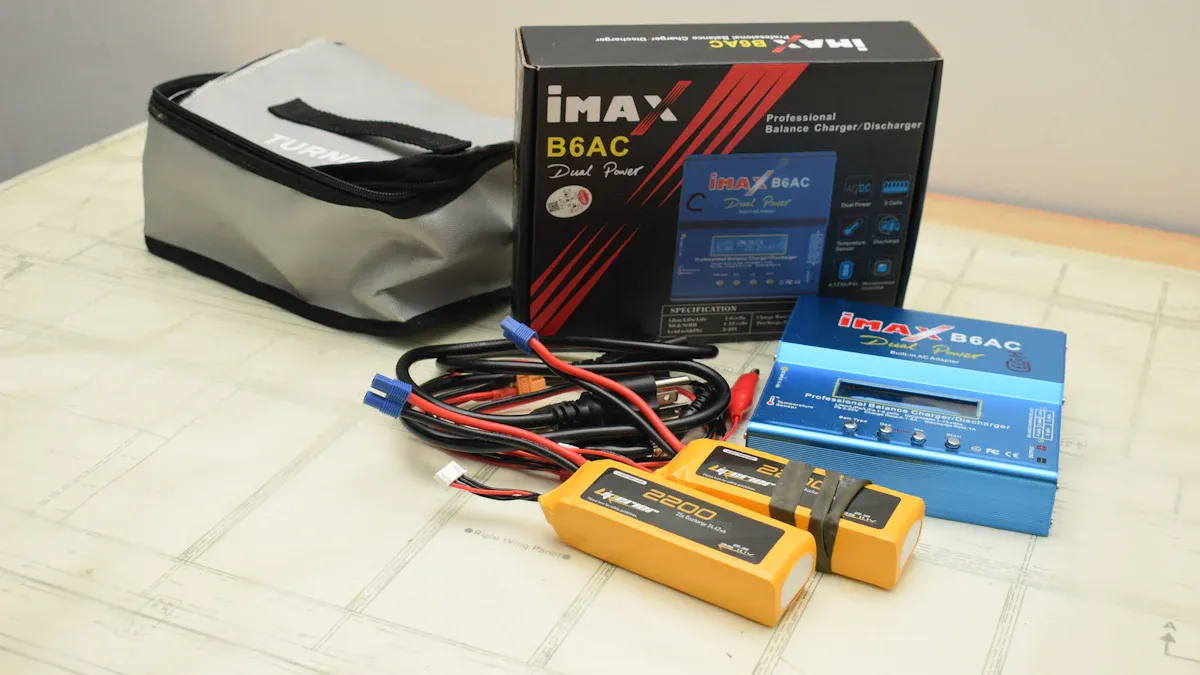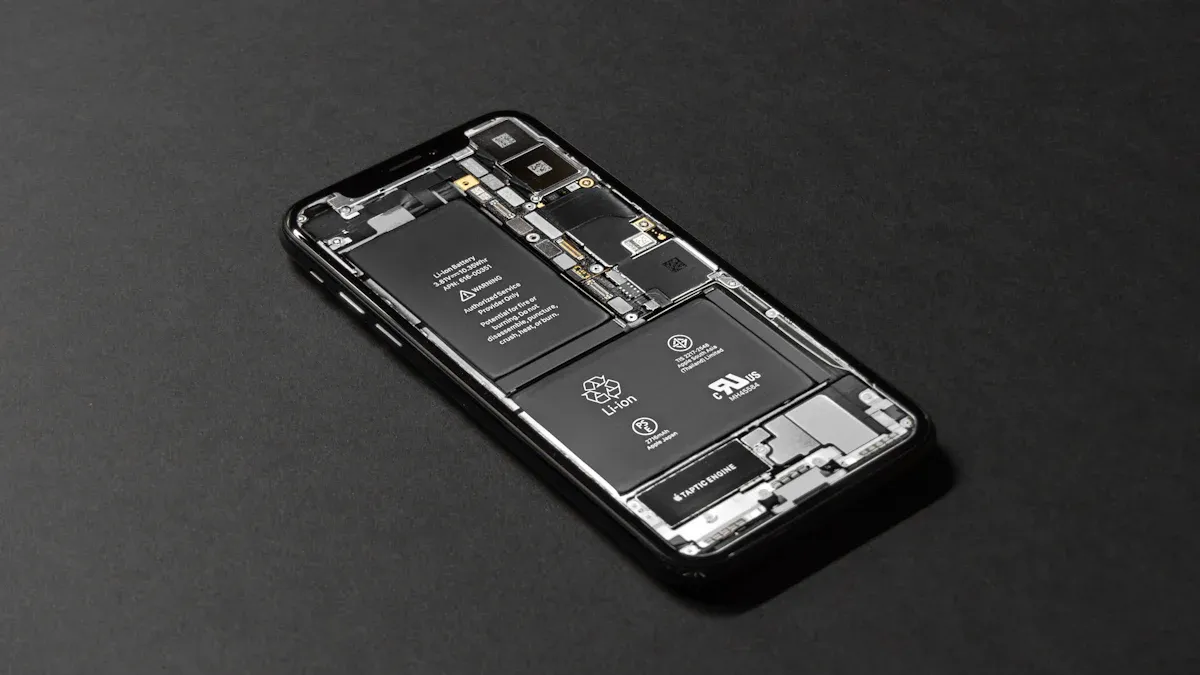
Smart li polymer battery technology refers to advanced lithium polymer batteries that include intelligent management systems for real-time monitoring and control. These smart lithium battery packs offer unique features such as high safety, flexible shapes, and adaptability for many devices. Key features include advanced diagnostics, customizable designs, and improved safety. The global market for lithium polymer batteries shows rapid growth, with a value of USD 1.65 billion in 2024 and a projected 17.9% CAGR through 2033:
| Metric | Value | Примечания |
|---|---|---|
| Current Market Size | $1.65B | 2024 |
| Projected Market Size | $7.30B | 2033 |
| Compound Annual Growth Rate | 17.9% | 2025-2033 |
| Asia-Pacific Market Share | 85% | China, Japan, South Korea lead |
Smart li polymer battery solutions help drive innovation in wearables, electric vehicles, and portable electronics.
Smart Li Polymer Battery Basics

Structure and Materials
Lithium polymer batteries stand out from traditional lithium-ion batteries because of their unique structure and materials. Instead of using a liquid electrolyte, lithium polymer batteries use a gel-like or solid polymer electrolyte. This change makes the battery safer and more flexible. The flexible aluminum foil pouch replaces the rigid metal casing found in older batteries. This design allows manufacturers to create batteries in many shapes and sizes, which helps fit them into slim or unusual spaces.
Some common materials used in lithium polymer batteries include:
- Carbon material for the negative electrode, which helps prevent dangerous lithium dendrite growth and increases safety.
- Gel electrolytes that provide a stable environment for ions to move, reducing the risk of leaks.
- Aluminum plastic film for the outer packaging, making the battery lighter and thinner.
- Wafer-thin layers, often less than 1mm thick, for a compact profile.
Примечание: Lithium polymer batteries offer high energy density (about 140 Wh/kg), low internal resistance, and a long service life—up to 1200 cycles at 80% depth of discharge. They also have a low self-discharge rate and no memory effect, making them reliable for many uses.
The flexible design and safer materials make lithium polymer batteries a popular choice for smart lithium battery packs in modern devices.
How It Works
A smart li polymer battery uses advanced technology to deliver power safely and efficiently. Inside the battery, ions move between the positive and negative electrodes through the polymer electrolyte. The flexible structure allows the battery to fit into many types of devices, from smartphones to drones.
Smart features set these batteries apart. Real-time diagnostics monitor the battery’s voltage, current, and temperature. This constant monitoring helps detect problems early, such as overheating or low charge. The battery management system adjusts charging and discharging to keep the battery within safe limits. Smart lithium battery packs can also communicate with devices using protocols like CAN bus or RS485, sending data about battery health and performance.
- Real-time data access allows users to check battery status without opening the device.
- Performance monitoring helps spot battery wear, so users can replace or service batteries before failure.
- Safety alerts warn users about overheating or other risks, preventing accidents.
Smart li polymer battery technology uses these features to improve safety, reliability, and efficiency. The smart lipo battery pack can even store historical data, supporting predictive maintenance and longer battery life.
Система управления аккумулятором
The battery management system (BMS) acts as the brain of smart lithium battery packs. It monitors, protects, and manages every cell in the battery. The BMS tracks voltage, current, temperature, state of charge (SOC), and state of health (SOH) for each cell. This careful monitoring helps prevent overcharging, over-discharging, and overheating.
| Function Category | Описание |
|---|---|
| Monitoring | Tracks voltage, current, temperature, SOC, and SOH of battery cells. |
| Защита | Prevents over-current, over-voltage, under-voltage, over-temperature, and under-temperature events. |
| Balancing | Distributes charge evenly among cells to maximize capacity and lifespan. |
| Терморегулирование | Controls battery temperature to prevent overheating and thermal runaway. |
| Diagnostics & Data | Collects data for diagnostics, estimates SOC and SOH, and communicates with external systems. |
| Future Capabilities | Enables predictive analytics, cloud-based control, and enhanced integration for better performance. |
The BMS uses smart algorithms, sometimes powered by AI or machine learning, to predict faults before they happen. Cloud integration allows remote monitoring and real-time updates. Modular design lets users isolate faulty sections, making repairs easier and extending the battery’s life.
Smart battery management systems ensure that lithium polymer batteries operate safely and last longer. They help balance the charge between cells, manage temperature, and provide data for diagnostics. These features reduce maintenance costs and improve the performance of smart lithium battery packs in everything from consumer electronics to industrial machines.
Key Advantages of Lithium-Polymer Batteries
Особенности безопасности
Lithium polymer batteries stand out for their advanced safety mechanisms. These batteries use a combination of smart technology and physical design to prevent overheating, short circuits, and other hazards. The safety features include:
- Smart charging circuits that cut off power automatically when the battery reaches full charge, which helps prevent overheating.
- Voltage monitoring systems that keep the battery operating within safe voltage ranges.
- Fail-safe mechanisms that shut down the battery if voltage thresholds are exceeded.
- Protective Circuit Modules (PCM) that detect and stop short circuits.
- Proper insulation and secure housing to prevent accidental contact between battery terminals.
- Fuse protection systems that disconnect power flow during faults.
- Shock-resistant enclosures and vibration-dampening materials that protect against mechanical damage.
- Battery Management Systems (BMS) that provide real-time diagnostics, automated safety cutoffs, and adaptive power management.
These safety mechanisms work together to make lithium polymer batteries reliable for sensitive uses, such as life-saving devices and medical equipment. In safety tests, smart lithium polymer batteries with special polymer membranes show much better performance than regular lithium-ion cells. The smart polymer membrane can double the time before thermal runaway, giving users a critical safety window. This improvement helps protect against fires and explosions, which is important for enhanced patient safety in hospitals and for military or industrial applications.
Примечание: Certified lithium polymer batteries meet strict safety standards (UL, CE, IEC), which ensures enhanced patient safety and device reliability.
Efficiency and Performance
Lithium polymer batteries deliver high energy density and excellent efficiency. These batteries can store more energy in a smaller, lightweight package compared to traditional lithium-ion batteries. The following table shows how they compare:
| Тип батареи | Плотность энергии (Втч/кг) | Charge/Discharge Efficiency (%) |
|---|---|---|
| Traditional Lithium Ion | 150-250 | 90-95 |
| Литий-полимер | 300-400 | Above 95 |
The extremely high energy density of lithium polymer batteries allows devices to run longer without needing frequent recharging. Their charge/discharge efficiency is above 95%, which means very little energy is lost during use. These advantages make them ideal for portable electronics, wearables, and IoT devices.
Lithium polymer batteries also support fast charging. They can reach 70-80% capacity within about an hour, which reduces downtime for users. The batteries deliver high power in a compact form, supporting complex features like GPS, fitness tracking, and continuous health monitoring. Their stable electrochemical behavior and wide operating temperature range (–40 °C to +85 °C) ensure reliable performance in different environments. The lightweight design makes them easy to carry, which is important for consumer electronics and medical devices that need a continuous source of power.
Devices such as smartwatches, drones, and medical monitors benefit from the long life cycles and stable power supply of lithium polymer batteries.
Customization and Flexibility
One of the key advantages of lithium-polymer batteries is their ability to fit almost any device design. Manufacturers can customize the shape, size, and capacity to match specific needs. The table below highlights some customization options:
| Customization Aspect | Подробности |
|---|---|
| Shape and Size | Thickness from 0.4mm to 14mm; can create compact, unusual, and special shapes. |
| Capacity Range | From 8mAh up to 10,000mAh+ |
| Assembly Options | Series (7.4V, 11.1V, 22.2V), parallel (2P, 3P, 4P, 5P), or combined packs (2S2P, 3P3S). |
| Additional Features | Protection circuits, adjustable cables, connectors, NTC thermistors for safety management. |
| Application Flexibility | Supports medical, consumer, industrial, and extreme environment devices. |
Lithium polymer batteries use a solid or semi-solid polymer electrolyte, which allows them to be thinner and lighter than other batteries. Pouch cells, a common form, are flexible sheets that fit tight spaces. Manufacturers can create curved or irregular shapes for devices like smart rings or wearable patches. This flexibility supports the design of ultra-thin smartphones, wearables, and drones.
- Lithium polymer batteries offer flexibility in shape and size, enabling sleeker and thinner device designs.
- The lightweight and compact form factor supports portability and longer battery life.
- Custom-shaped batteries help avoid redesigning entire products, saving time and cost.
These features make lithium polymer batteries the top choice for modern electronics, medical equipment, and industrial tools. Their adaptability allows engineers to create new products that were not possible with older battery types.
Lithium polymer batteries provide the flexibility and safety features needed for next-generation devices in healthcare, military, and consumer markets.
Lithium Polymer Battery vs Other Types
Li-ion and LiFePO4 Comparison
Lithium polymer batteries stand out when compared to other popular battery types, such as lithium-ion (Li-ion) and lithium iron phosphate (LiFePO4). Each type has unique strengths and weaknesses. The table below highlights key differences:
| Тип батареи | Плотность энергии (Втч/кг) | Cycle Life (Charge-Discharge Cycles) | Safety Characteristics |
|---|---|---|---|
| Литий-полимер | 150-200 | 300-1000 | Prone to swelling and thermal runaway; flexible casing; needs careful handling |
| LiFePO4 | 90-120 (up to 160) | 2000-6000+ | Very stable; robust casing; less risk of fire or explosion; tolerates high and low temperatures |
| Литий-ионный | 120-180 | 500-2000 | Varies by chemistry; some types have overheating risks; generally less flexible in shape |
Lithium polymer batteries offer high energy density and flexible shapes, making them ideal for slim devices. LiFePO4 batteries provide longer cycle life and superior safety, which suits applications that need long-term reliability. Lithium-ion batteries balance energy density and cost but do not match the flexibility of lithium polymer batteries.
Tip: Lithium polymer batteries can be shaped to fit unique spaces, while LiFePO4 batteries work best where safety and long life matter most.
Плюсы и минусы
Smart lithium polymer batteries bring many benefits, but they also have some drawbacks. The table below summarizes the main points:
| Pros of Smart Lithium Polymer Batteries | Cons of Smart Lithium Polymer Batteries |
|---|---|
| High energy density for compact, lightweight devices | Higher upfront cost than other types |
| Fast charging and low self-discharge rate | Shorter lifespan with capacity loss over time |
| Flexible shapes and sizes for custom designs | Safety risks like swelling or fire if damaged |
| Built-in protection circuits for better safety | Sensitive to temperature extremes |
| Modular and stackable for scalable power | Environmental concerns from disposal |
- Smart lithium polymer batteries use solid or gel electrolytes, which allow for thin and light designs.
- Built-in protection circuits help prevent overcharging and overheating, improving safety.
- These batteries fit well in wearables, drones, and medical devices where space and weight matter.
Однако, manufacturing lithium polymer batteries can be complex and costly. They require careful handling to avoid damage. Disposal and recycling also present environmental challenges due to toxic metals.
Note: Choosing the right battery depends on the needs of the device. Lithium polymer batteries work best for portable electronics that need high energy density and flexible shapes.
Integration and Applications

Бытовая электроника
Lithium polymer batteries play a major role in consumer electronics. Their lightweight and compact design allows manufacturers to create thinner and lighter devices. Many people ask, what are lithium-polymer batteries used for? The answer includes a wide range of products:
- Смартфоны
- Tablets
- Ноутбуки
- Wearables like smartwatches and fitness trackers
- Drones and cameras
These batteries support slim and flexible shapes, making them ideal for foldable phones and curved displays. Высокая плотность энергии ensures longer device runtime, while fast charging reduces waiting time. The gel-like electrolyte lowers the risk of leaks or fires, improving safety. Devices such as smartwatches and fitness trackers benefit from the ability to mold batteries into small, curved forms. This flexibility supports innovation in wearables and IoT devices.
Electric Vehicles and Industry
Electric vehicles depend on lithium polymer batteries for reliable power and safety. Передовые системы управления аккумуляторами monitor temperature, voltage, and state of charge. These systems protect the battery from faults and extend its lifespan. In electric vehicles, smart lipo battery pack technology enables fast charging and stable performance. The same technology powers unmanned aerial vehicles (UAVs) and drones, providing high energy density for longer flights.
Industrial automation also uses lithium polymer batteries. Automated guided vehicles, robots, and IoT-enabled equipment rely on these batteries for continuous operation. Real-time monitoring and predictive maintenance reduce downtime. The batteries’ compact size and high energy density support efficient, uninterrupted work in factories and warehouses.
Custom Solutions
Manufacturers design custom lithium polymer battery pack solutions for specialized applications. They tailor capacity, voltage, and shape to fit unique devices. Examples include:
- Medical devices like insulin pumps and blood pressure monitors
- Smart pet toys and laser distance meters
- Agriculture tools for feeding and irrigation systems
- Power tools, marine equipment, and electric wheelchairs
- Drones, UAVs, and unmanned aerial vehicles
Custom batteries meet strict safety standards and support advanced features like remote diagnostics and thermal management. This adaptability answers the question, what are lithium-polymer batteries used for, across many fields. Engineers can create batteries for harsh environments, miniaturized electronics, and high-performance vehicles.
Smart li polymer battery technology offers unique advantages for modern industries. Key benefits include:
- Improved reliability and reduced downtime
- Energy savings and operational efficiency
- Flexibility in shape and lightweight design
- Enhanced safety and high power density
| Innovation Area | Описание |
|---|---|
| Material Innovations | Solid-state electrolytes and graphene for better safety and energy density |
| Structural Advances | Flexible, foldable designs for new device shapes |
| Safety Improvements | Advanced management systems for real-time monitoring |
These features make smart batteries a strong choice for future-ready applications. Readers can explore new trends and consider these solutions for their next project.
ЧАСТО ЗАДАВАЕМЫЕ ВОПРОСЫ
What makes a Li polymer battery “smart”?
A smart Li polymer battery uses a battery management system (BMS). The BMS tracks voltage, temperature, and charge. It helps keep the battery safe and working well. The battery can also send data to devices for better control.
Can smart Li polymer batteries catch fire?
Smart Li polymer batteries have safety features that lower fire risk. The BMS stops overcharging and overheating. Protective circuits and special materials add more safety. Users should still avoid damage or using the battery in extreme heat.
How long do smart Li polymer batteries last?
Most smart Li polymer batteries last between 300 and 1,000 charge cycles. Good care, like avoiding deep discharges and high temperatures, helps them last longer. The BMS also helps extend battery life by balancing cells and preventing damage.
Are smart Li polymer batteries safe for children’s devices?
Manufacturers design smart Li polymer batteries with safety in mind. Features like short-circuit protection and thermal management make them safer for toys and wearables. Parents should still follow safety instructions and use only approved chargers.

